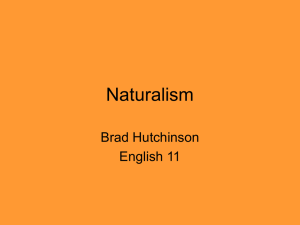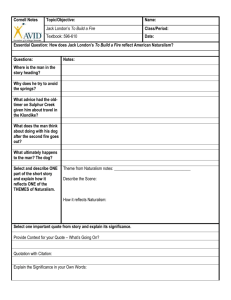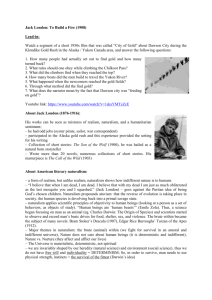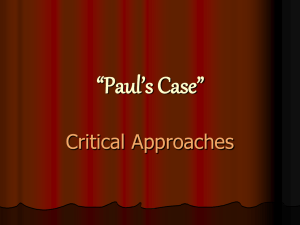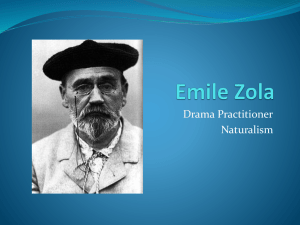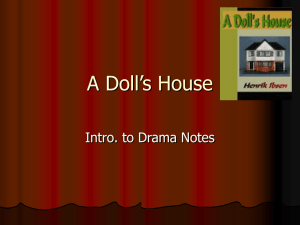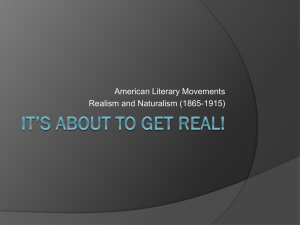19th Century Realism
advertisement
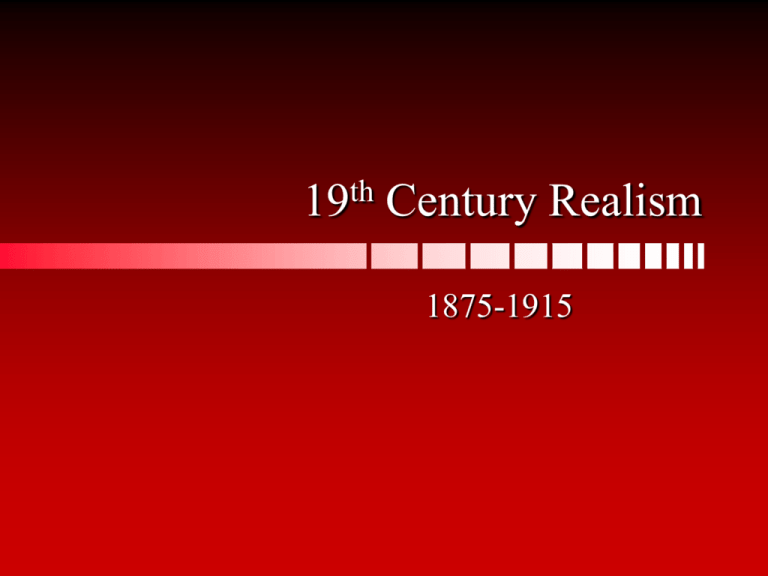
19th Century Realism 1875-1915 Realism • Drama was to involve the direct observation of human behavior • Use contemporary settings and time periods • Uses temporary life and problems as subjects • No subject matter should be excluded from the stage • Economic injustices, sexual double standards, unhappy marriages, disease, religious hypocrisy • People move and talk in a manner similar to that of our everyday behavior • This is accomplished through realistic settings and natural speech • It holds the idea of the stage as an environment, rather than as an acting platform. It presents a theatrical verisimilitude (true to life) that would more objectively portray life as recognizable to the audience. • Not always a neat and happy ending According to the Realist view… • General precepts: • Truth is verified through science • The scientific method—observation—would solve everything • Scientific methodology can apply to human problem solving. • Art had as its purpose to better mankind • Purpose of drama was to call the audience’s attention to social problems in order to bring about change Realism in Art Courbet’s Spinner Daumier’s Third Class Carriage Millet’s Gleaners Monet’s The Beach at St. Addresse Realism Plays • • • • A Doll's House by Henrik Ibsen The Cherry Orchard by Anton Chekhov Uncle Vanya by Anton Chekhov Major Barbara by George Bernard Shaw A Doll’s House (1879) • • The play focuses on Nora, a woman trapped in a marriage in which she is treated by her husband as an object – a doll – as she was treated by her father previously. When she innocently gets into trouble over a financial arrangement by using forgery, her husband Torvald does not stand behind her, even though it was to save him. She discovers her unequal status in her home when her forgery is revealed in a letter sent to Torvald by a fired employee, Krogstad. Even when Krogstad takes back the letter because he is to marry Nora’s friend Mrs. Linde, Nora realizes that she can no longer live with Torvald in a relationship in which she is treated like a child. The play closes with Nora leaving her home, slamming the door behind her. Constantin Stanislavski • Founder of the Stanislavskian Technique or Method Acting • “The actor must first of all believe in everything that takes place onstage, and most of all, he must believe what he himself is doing. And one can believe only in the truth.” • He developed a series of exercises and techniques for the actor which is still being used today by famous actors in films and on stage. Stanislavskian Techniques • Relaxation • Unwanted tension has to be eliminated to attain a state of physical and vocal relaxation • Concentration and Observation • Importance of Specifics • A performer should never try to act in general, he said, and should never try to convey a feeling such as fear or love in some vague way • In life, we express emotions in terms of specifics • Inner Truth • The “Magic If” – through it we can imagine ourselves in virtually any situation Stanislavskian Techniques • What? Why? How? • Everything on stage must have a purpose • Through Line of a Role • Finding the superobjective of a character • What is it, above all else, that the character wants during the course of the play? • Ensemble Playing • Many performers tended to “stop acting” or lose concentration when they were not the main character in a scene, which weakens the sense of ensemble Naturalism vs. Realism • Naturalism was an extreme form of Realism where all characters were the product of their environment. • Decisions were made based on what nature had caused. • If a person stole bread, it was justified because he was hungry. • Emile Zola (Theres Raquin), and Gorky (The Lower Depths) are noted Naturalists • NOTE: Production values are similar to Realism. Two Kinds of Naturalism • Naturalism A • Playwright takes a troubling social problem and puts it on stage without any attempt to change things or alter anything so the audience can look at it objectively, scientifically, and come to a solution ourselves • The artist does not suggest or propose a solution; they only put it on display so the audience has to find the answer for themselves • OBJECTIVITY is the point of Naturalism A – the author does not get to mediate between the stage and the audience, only observes and presents • It is also impossible, because artistic objectivity is a myth • We live in an era of Naturalism A, with reality TV – there is a sense of objectivity, an illusion of it • Example: House of Sand and Fog • Problem with Naturalism A • Presumes the audience feels the same way and presumes objectivity can be shown Two Kinds of Naturalism • Naturalism B • Objectivity disappears – the artist takes a situation that is morally despicable and puts it on probably worse than it is and doesn’t do anything to soften it up so that people will think that it is awful • No moral center anywhere • moral center is presumed to be in the audience • The Protagonist is awful, the objective is horrible and most of the time they achieve it – mostly villains or victims • Teaches through a bad example • Playwright: David Mamet • Example: The Shape of Things by Neil Labute • Problem with Naturalism B • Deals with people behaving horribly and getting away with it and no one in the play mediates the piece Realism v. Naturalism • A realist attacking naturalism: • Ibsen: “M. Zola descends to the gutter to wallow in it. I descend to the gutter to clean it up.” • Zola's answer is more of “I'm putting it there so the audience is the raisseneur; the audience should go, 'oh, that's interesting. We can fix this problem if we...'” Vsevelod Meyerhold (1874-1940) • Antirealist director in Russia • Wanted to shatter the “fourth wall” • Searched for found spaces – streets, factories, schools – to present his work • Founded biomechanics, which emphasized external physical training and performance style • An actor’s body could be trained to operate like a machine and through physical actions, performers could evoke desired internal responses in themselves and their audience • Used constructivist sets, which used skeletal frames, ramps, stairways and platforms not meant to indicate a specific location Constructivist Set
